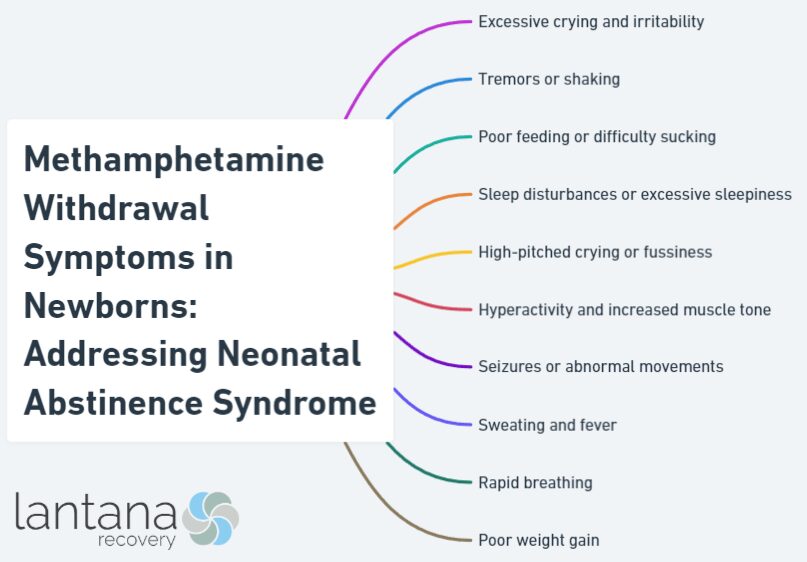Methamphetamine withdrawal symptoms in newborns, also known as Neonatal Abstinence Syndrome (NAS), is a concerning issue that requires attention and proper management. NAS refers to the set of symptoms that occur in newborns who have been exposed to methamphetamine during pregnancy and experience withdrawal after birth. Understanding NAS is crucial to effectively address the challenges it poses.
Neonatal Abstinence Syndrome (NAS) is a condition that occurs when newborns experience withdrawal symptoms after being exposed to drugs, including methamphetamine, in the womb. The exposure to methamphetamine during pregnancy can lead to physical dependence in the fetus, resulting in withdrawal symptoms after birth.
There are several factors that contribute to the development of NAS, including the mother’s substance abuse during pregnancy, the duration and amount of drug use, and the timing of drug use during pregnancy. Not all infants exposed to methamphetamine will develop NAS, but certain risk factors increase the likelihood.
Signs and symptoms of methamphetamine withdrawal in newborns can vary widely and may include physical symptoms such as tremors, excessive crying, poor feeding, and gastrointestinal issues. Behavioral symptoms may include irritability, agitation, and difficulty sleeping.
Diagnosing NAS involves a medical assessment and observation of the newborn’s symptoms. Scoring systems, such as the Finnegan Neonatal Abstinence Scoring System, are commonly used to assess and diagnose NAS based on the severity and duration of symptoms.
Treating NAS requires a multidisciplinary approach. Non-pharmacological treatment options, such as rooming-in, proper nutrition, and soothing techniques, can help manage withdrawal symptoms. In more severe cases, pharmacological interventions may be necessary to alleviate symptoms and ensure the newborn’s well-being.
Managing the long-term effects of NAS is essential, as infants exposed to methamphetamine may be at an increased risk for developmental delays and behavioral problems. Early intervention programs and support services can play a vital role in addressing these potential long-term effects.
Prevention and support for pregnant women struggling with substance abuse are crucial in mitigating the effects of NAS. Early intervention, support programs, rehabilitation, and counseling services can help pregnant women overcome addiction, reduce the risks of NAS, and improve overall outcomes for both mother and baby.
By understanding the complexities of methamphetamine withdrawal in newborns and addressing Neonatal Abstinence Syndrome through appropriate diagnosis, treatment, long-term management, and support, we can better support the health and well-being of these vulnerable infants and their mothers.
Understanding Neonatal Abstinence Syndrome is crucial in addressing challenges faced by newborns exposed to methamphetamine withdrawal. Here are key points to consider:
- Neonatal Abstinence Syndrome (NAS) occurs when a baby is exposed to addictive substances, such as methamphetamine, in the womb.
- NAS symptoms include tremors, irritability, feeding difficulties, and respiratory issues.
- NAS can have long-term effects on the baby’s development, including cognitive and behavioral challenges.
- The severity of NAS symptoms varies based on factors such as substance exposure duration and amount, as well as the baby’s overall health.
- Early identification and intervention are crucial for managing NAS. Medical professionals use screening tools and observation to assess the baby’s condition.
- Treatment for NAS may include non-pharmacological approaches, such as comforting techniques, and medication if necessary.
- Supportive care from healthcare professionals and a nurturing environment from caregivers are essential for helping babies with NAS thrive.
- Education and support for parents and caregivers are vital for understanding and managing challenges associated with NAS.
What Is Neonatal Abstinence Syndrome ?
Neonatal Abstinence Syndrome (NAS) is a condition that affects newborns exposed to substances, like methamphetamine, during pregnancy. NAS is a withdrawal syndrome that occurs when infants are no longer exposed to these substances in the womb. It can cause physical and behavioral symptoms that are distressing for both infants and caregivers.
NAS is primarily caused by a pregnant woman’s substance use, including methamphetamine. These substances pass through the placenta to the fetus, leading to dependence and subsequent withdrawal symptoms after birth, suggests a study exploring the impact of meth use during pregnancy on newborns published in The American Journal Of Diseases Of Children.
Common signs of methamphetamine withdrawal in newborns include trembling, excessive crying, poor feeding, irritability, and difficulty sleeping. Behavioral symptoms like hyperactivity, restlessness, and difficulty staying calm may also be present.
Diagnosing NAS involves medical assessment and observation of the newborn’s symptoms. Scoring systems may be used to evaluate the severity of withdrawal symptoms and guide treatment decisions.
Treatment for NAS may include both non-pharmacological and pharmacological options, depending on symptom severity. Non-pharmacological measures include creating a calm environment, ensuring proper nutrition, and utilizing techniques like swaddling and gentle rocking. Medication may be considered in more severe cases.
Managing the long-term effects of NAS is crucial for the infant’s well-being and development. Early intervention programs can address developmental delays or challenges that may arise. Rehabilitation and counseling services can support mothers in overcoming substance use disorders and preventing future cases of NAS.

Causes of Neonatal Abstinence Syndrome
Neonatal Abstinence Syndrome (NAS) refers to the condition in which newborns experience withdrawal symptoms from addictive substances that they were exposed to in the womb. Various factors contribute to the development of NAS, including maternal drug use throughout pregnancy, the length of time the fetus was exposed to drugs, the specific type and dosage of drugs used, genetic and metabolic factors, as well as the presence of polydrug use.
It is crucial to ensure comprehensive prenatal care and to avoid the use of addictive substances in order to prevent NAS. Moreover, early intervention, support programs, rehabilitation, and counseling services are essential for promoting the health and well-being of both the mother and the baby. By addressing the underlying causes of NAS and providing the necessary support, the occurrence of this syndrome can be reduced, leading to improved outcomes for newborns.
Who Is at Risk for NAS?
Neonatal Abstinence Syndrome (NAS) occurs in newborns exposed to substances like methamphetamine during pregnancy. Identifying those at risk for NAS, including pregnant women with a history of substance abuse, is crucial for providing appropriate care and support.
Women using methamphetamine during pregnancy are at high risk of having babies with NAS. Methamphetamine crosses the placenta and directly affects the developing fetus, causing withdrawal symptoms after birth. In addition, pregnant women with a history of substance abuse, including methamphetamine use, are also at increased risk of having infants with NAS. Healthcare providers should identify and support these women throughout pregnancy to minimize harm to the baby.
“Methamphetamine-exposed infants whose mothers smoked had significantly decreased growth relative to infants exposed to methamphetamine alone,” reports a research published in Journal of Developmental & Behavioral Pediatrics. (Effects of Prenatal Methamphetamine Exposure on Fetal Growth and Drug Withdrawal Symptoms in Infants Born at Term, Smith et al., 2003)
The severity of NAS symptoms varies based on factors such as the amount and duration of maternal methamphetamine use, as well as individual differences in drug metabolism. Infants whose mothers used methamphetamine regularly or in high doses are more likely to experience severe withdrawal symptoms. Other risk factors for NAS include maternal use of multiple substances, inadequate prenatal care, maternal stress, and exposure to violence or other adverse life events during pregnancy. These factors contribute to the overall risk of NAS and should be considered during prenatal care and intervention.
By identifying individuals at high risk for NAS, healthcare providers can implement appropriate interventions and support systems. Early detection and treatment can significantly improve outcomes for infants affected by methamphetamine withdrawal symptoms.

Signs and Symptoms of Methamphetamine Withdrawal in Newborns
The signs and symptoms of methamphetamine withdrawal in newborns reveal the challenging journey these infants face as they navigate neonatal abstinence syndrome. From physical manifestations to behavioral changes, understanding the effects of methamphetamine withdrawal in newborns is crucial in providing the necessary support and care. Let’s dive into the vivid landscape of these symptoms, exploring the physical and behavioral challenges that these vulnerable little ones endure.
Physical Symptoms of Methamphetamine Withdrawal in Newborns
Physical symptoms of methamphetamine withdrawal in newborns, such as tremors, increased muscle tone, excessive crying, gastrointestinal distress, and respiratory difficulties, can manifest within the first few days after birth. It is crucial for healthcare providers and caregivers to promptly recognize and address these symptoms to ensure the well-being of the newborn.
When newborns experience methamphetamine withdrawal, medical attention and proper care are necessary. Healthcare professionals utilize scoring systems to assess the severity of neonatal abstinence syndrome (NAS) and determine the most suitable treatment. Non-pharmacological approaches, such as swaddling and creating a calm environment, can help soothe the newborn and alleviate symptoms.
In severe cases, pharmacological treatment options like morphine or methadone may be required to manage withdrawal symptoms. These medications are administered under medical supervision to reduce symptom severity and ensure the newborn’s comfort.
As we delve into the subject of using medicines for methamphetamine withdrawal, it’s worth discussing the role of Clonidine, which is commonly used for managing benzodiazepine withdrawal. This comparison sheds light on the versatile applications of Clonidine in addressing withdrawal symptoms across different substances, providing insights into potential strategies for easing the challenges of methamphetamine withdrawal.
Prompt recognition and addressing of the physical symptoms of methamphetamine withdrawal in newborns enable healthcare providers to offer the necessary support and interventions to improve the overall well-being of the infants.
Behavioral Symptoms of Methamphetamine Withdrawal in Newborns
In newborns experiencing methamphetamine withdrawal, the behavioral symptoms of methamphetamine withdrawal include persistent, inconsolable crying, irritability, difficulty sleeping, tremors or shaking, hypersensitivity to stimuli, poor feeding, excessive sucking, difficulty bonding, delayed motor development, and hyperactivity.

Diagnosing Neonatal Abstinence Syndrome
When it comes to diagnosing Neonatal Abstinence Syndrome, there are key factors that need to be considered. Medical assessment and observation play a crucial role in identifying the symptoms and impacts on newborns. Additionally, scoring systems for NAS diagnosis provide a standardized approach to evaluating the severity of withdrawal symptoms. By understanding these diagnostic methods, healthcare professionals can effectively address the challenges associated with NAS and provide appropriate care for affected infants.
Medical Assessment and Observation
Medical assessment and observation play a crucial role in diagnosing neonatal abstinence syndrome (NAS) caused by methamphetamine withdrawal in newborns. Healthcare professionals carefully monitor the newborn’s physical symptoms and behaviors during the assessment process to detect any signs of methamphetamine withdrawal. This comprehensive evaluation includes observing the baby’s heart rate, respiratory rate, sleep patterns, tremors, and muscle tone. By closely observing these indicators, healthcare professionals can assess the severity of withdrawal symptoms and determine the most appropriate course of treatment.
Moreover, observation also allows healthcare providers to evaluate the overall well-being of the newborn, including their feeding patterns, weight gain, and any additional complications that may arise as a result of methamphetamine withdrawal.
Furthermore, both medical assessment and observation provide a baseline for future monitoring and treatment. Regular evaluation enables healthcare professionals to make necessary adjustments to the treatment plan in order to ensure the baby’s health and development progress as expected.
Using Scoring Systems for NAS Diagnosis
The process of diagnosing Neonatal Abstinence Syndrome (NAS) involves using scoring systems. These scoring systems help healthcare professionals assess the severity of withdrawal symptoms in newborns who have been exposed to methamphetamine. One commonly used scoring system for NAS is the Finnegan Neonatal Abstinence Scoring System.
With the Finnegan system, healthcare providers evaluate both the physiological and behavioral signs in newborns. Each symptom is given a numerical value, allowing for a quantitative assessment of the severity of withdrawal. Symptoms such as tremors, excessive crying, and disturbed sleep are carefully evaluated and scored to determine the overall withdrawal score.
The scores obtained from the Finnegan system serve as a guide for healthcare professionals in providing the appropriate treatment and care. Depending on the severity of symptoms, newborns with NAS may need medication, such as morphine, for effective symptom management.
However, it is important to note that scoring systems for NAS diagnosis should not be considered as definitive diagnostic tools. Instead, they are valuable clinical guides. Healthcare providers assess symptoms and gather additional medical information to ensure an accurate diagnosis.
Pro-tip: If you suspect that your newborn may be experiencing withdrawal symptoms from methamphetamine exposure, it is crucial to consult a healthcare professional for an assessment. Scoring systems like the Finnegan Neonatal Abstinence Scoring System can assist in determining the most suitable treatment and care for your newborn.

Treating Neonatal Abstinence Syndrome
Treating Neonatal Abstinence Syndrome takes a multi-faceted approach in addressing the specific needs of newborns experiencing methamphetamine withdrawal symptoms. In this section, we’ll explore various treatment options, including non-pharmacological and pharmacological interventions. Discover how healthcare professionals are actively working towards minimizing the discomfort and promoting the healthy development of newborns affected by Neonatal Abstinence Syndrome.
Non-Pharmacological Treatment Options
When it comes to treating Neonatal Abstinence Syndrome (NAS) caused by methamphetamine withdrawal in newborns, there are several non-pharmacological treatment options available:
- Swaddling: Swaddling can reduce withdrawal symptoms by providing comfort and security.
- Gentle Touch and Massage: Gentle touch and massage can soothe the baby and promote relaxation.
- Room Environment: Creating a calm and quiet environment can help the baby recover by minimizing stimulation.
- Non-Nutritive Sucking: Allowing the baby to suck on a pacifier or finger can alleviate withdrawal symptoms.
- Supportive Care: Consistent care and emotional support can promote the baby’s well-being and alleviate stress.
It is important to note that the effectiveness of these non-pharmacological treatment options may vary depending on the severity of the withdrawal symptoms and the individual needs of the baby. Medical professionals should carefully assess and monitor the baby’s progress to determine the most suitable treatment approach.
Pharmacological Treatment Options
Pharmacological Treatment Options for Neonatal Abstinence Syndrome (NAS) involve using medication to alleviate withdrawal symptoms in newborns. These are given in decreasing doses to manage symptoms and reduce their severity. The dosage and duration depend on NAS severity and the baby’s response.
According to American Academy of Pediatrics, Morphine is the most commonly used drug in the treatment of NAS secondary to opioids. Another option is non-opioid medication like clonidine, which is used to manage symptoms like hypertension and agitation. It reduces the release of norepinephrine, a neurotransmitter involved in withdrawal symptoms. In some cases, a combination of medications may be used.
The choice of medication should be determined by a healthcare professional experienced in managing NAS. Pharmacological treatment is typically used alongside non-pharmacological interventions like swaddling and soothing techniques to provide holistic care and promote newborn well-being. However, it’s essential to consult a healthcare professional to determine the appropriate treatment plan for each individual case.
Managing Long-Term Effects of NAS
Managing the long-term effects of NAS (Neonatal Abstinence Syndrome) requires addressing the physical, cognitive, and emotional needs of affected newborns. Strategies to consider include:
- Medical interventions: Healthcare professionals must closely monitor for developmental delays or medical issues. Medications may alleviate withdrawal symptoms and manage related health conditions.
- Early intervention programs: Occupational therapy, physical therapy, and speech therapy can address developmental delays and support a child’s growth and well-being.
- Supportive care: A nurturing and stable environment is essential for emotional and social development. Establish routines, consistent caregivers, and promote attachment with primary caregivers.
- Parent education and support: Educate parents about the long-term effects of NAS and empower them with strategies to support their child’s development. Parent support groups offer guidance and emotional support.
- Educational accommodations: Provide additional educational support to address learning difficulties or cognitive impairments resulting from NAS. Individualized Education Programs (IEPs) can tailor strategies to meet the child’s needs.
Each child’s journey is unique, so interventions should be tailored to their specific needs. With support, early intervention, and a nurturing environment, children with NAS can thrive and reach their full potential.

Prevention and Support for Pregnant Women
Expectant mothers facing methamphetamine addiction require comprehensive support and prevention measures to combat potential neonatal abstinence syndrome in newborns. In this section, we explore effective strategies for pregnant women, including early intervention initiatives and the availability of rehabilitation and counseling services. By highlighting these avenues of prevention and support, we can foster a healthier environment for expectant mothers and their babies, mitigating the impact of methamphetamine withdrawal symptoms on newborns.
Early Intervention and Support Programs
Early intervention and support programs are crucial in addressing neonatal abstinence syndrome (NAS) in newborns experiencing methamphetamine withdrawal symptoms. These programs, known as early intervention and support programs, provide timely assistance and support to both the infants and their mothers.
- Medical Assistance: Skilled healthcare professionals closely monitor newborns for signs of NAS. They conduct medical assessments and observations to determine the severity of symptoms and develop treatment plans as part of the early intervention and support programs.
- Parent Education: These early intervention and support programs educate parents, especially mothers, about the effects of methamphetamine use during pregnancy and the risks associated with NAS. By providing comprehensive information and resources, they help parents better understand their infants’ needs and participate in their treatment, which is an essential component of these programs.
- Counseling and Support: Early intervention and support programs offer counseling services as a part of their comprehensive approach. This includes individual counseling and support groups at a drug addiction treatment center, where mothers can share their experiences and receive guidance on coping strategies and bonding with their infants. Such counseling and support play a vital role in the success of these early intervention and support programs.
- Developmental Support: The core objective of early intervention and support programs is to facilitate the overall development of newborns affected by NAS. They provide specialized therapies, such as physical therapy, occupational therapy, and speech therapy, to address developmental delays and promote growth and well-being. This developmental support is an integral part of these programs.
- Follow-up Care: Early intervention and support programs ensure regular follow-up visits to monitor the progress of infants and their mothers after the initial treatment. This ongoing support helps manage any long-term effects of NAS and provides guidance for mothers in their parenting journey. Follow-up care is a crucial aspect of these programs.
Early intervention and support programs are vital in ensuring that infants affected by NAS receive the necessary care and support during this critical period. Implementing these programs can enhance the well-being and long-term outcomes for these newborns and their families.
Early intervention and support programs for newborns with NAS have been developed in response to increasing awareness of the challenges faced by infants exposed to methamphetamine during pregnancy. These early intervention and support programs have shown promising results in improving outcomes and providing essential support to affected families. Through collaboration between healthcare professionals, counselors, and community organizations, early intervention programs continue to evolve and adapt to meet the unique needs of newborns and their mothers affected by NAS.
Rehabilitation and Counseling Services
Rehabilitation and counseling services play a crucial role in addressing Neonatal Abstinence Syndrome (NAS) in newborns who are going through methamphetamine withdrawal symptoms. These services are essential in providing support to infants and their families.
- Counseling services offer parents and caregivers dealing with NAS challenges emotional support and guidance. They provide a safe environment for them to express their concerns and explore effective coping strategies and parenting techniques for infants with NAS.
- Rehabilitation services aid infants in reaching their developmental milestones and overcoming challenges caused by methamphetamine exposure. These services encompass physical therapy, occupational therapy, and speech therapy.
- Counseling and rehabilitation services educate parents about the long-term effects of NAS and provide effective management techniques. They also provide information on soothing techniques for infants, promoting healthy attachment, and creating a nurturing environment for their development.
- Furthermore, rehabilitation and counseling services work in collaboration with healthcare professionals to ensure a comprehensive approach to NAS treatment. This collaboration addresses the physical, behavioral, and emotional aspects of the condition.
Rehabilitation and counseling services are vital components of a holistic treatment plan for infants with NAS. They provide the necessary support and resources for their well-being and future success.
Frequently Asked Questions
1. What is neonatal abstinence syndrome (NAS) and what substances can cause it?
Neonatal abstinence syndrome (NAS) refers to the withdrawal symptoms experienced by newborns due to maternal drug use during pregnancy. Various substances, including crystal methamphetamine and opioid medicines, can cause NAS.
2. What factors are commonly associated with pregnant individuals who use methamphetamines?
Pregnant individuals who use methamphetamines tend to be younger, have lower education levels, lower socioeconomic status, and are more likely to drink and smoke during pregnancy. They also receive less prenatal care.
3. What are the challenges in standardizing care for NAS due to crystal methamphetamine withdrawal?
The varying withdrawal symptoms observed in neonates make it difficult to establish a standardized treatment protocol for NAS caused by crystal methamphetamine withdrawal. This poses challenges in providing consistent care to affected newborns.
4. How is NAS diagnosed and what tests can be done to confirm drug use?
Diagnosis of NAS is based on the mother’s history of substance abuse. A scoring system may be used to determine the severity of withdrawal. Meconium, urine, and umbilical cord blood tests can also be done to confirm drug use in both the mother and the newborn.
5. What are the treatment options for NAS and when are medications necessary?
Treatment for NAS usually involves both non-pharmacological and pharmacological approaches. Non-pharmacological treatment includes wrapping the baby snugly in a blanket for comfort, adding extra calories to their feedings, and providing IV fluids if necessary. Medical withdrawal management includes medications from the same drug family as the one the baby was exposed to may be necessary for severe withdrawal symptoms.
6. What are the potential complications and long-term effects of NAS?
Potential complications of NAS include feeding difficulties, respiratory problems, and developmental delays. Prenatal drug exposure, even without NAS, can lead to developmental delay. Specific drugs have been linked to specific problems in babies. Close medical supervision and prompt cessation of drug use can help prevent NAS.









